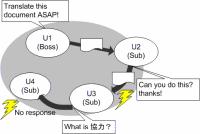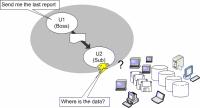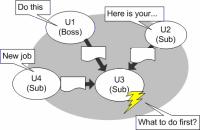Contextual Design Models
A contextual design model is a tool used to highlight observations and visualize the larger patterns of user intents and breakdowns. We used contextual design models to identify design problems, inspire design themes, and create a design vision over the course of several grounded brainstorming sessions.
Our team chose to focus on contextual design models specific to Knowledge Worker's workflow, culture, and artifacts. We concentrated on workflow to identify breakdowns in communication, cultural to explore social impacts of group collaboration, and artifact to review the current collaboration tools used and identify areas for improvement.
Consolidated Contextual Design Models
 1. Collaborative editing. In this scenario, the liasion has to hand off the final edited version but instead sends the document off before all edits are collected. The breakdown occurs when one user sends their edits back to the originator of the email, instead of the task owner.
1. Collaborative editing. In this scenario, the liasion has to hand off the final edited version but instead sends the document off before all edits are collected. The breakdown occurs when one user sends their edits back to the originator of the email, instead of the task owner.
 2. Asking for help. In this situation, the user needs to ask a coworker for assistance, but they don't know who to ask (who knows what). The result is the dreaded black hole of email requests.
2. Asking for help. In this situation, the user needs to ask a coworker for assistance, but they don't know who to ask (who knows what). The result is the dreaded black hole of email requests.
 3. Not knowing where to find information. Work objects such as documents are kept in a variety of locations and are not always clearly visible to all team members.
3. Not knowing where to find information. Work objects such as documents are kept in a variety of locations and are not always clearly visible to all team members.
 4. Multiple tasks given to a user at once. Often, users receive several competing tasks that are all due at the same time. How do users know what to do first?
4. Multiple tasks given to a user at once. Often, users receive several competing tasks that are all due at the same time. How do users know what to do first?
 5. Too many reminder systems in different places. Knowledge Workers keep a number of reminder systems for personal and professional tasks. Breakdowns occur in the form of data loss when transferring from one repository to another.
5. Too many reminder systems in different places. Knowledge Workers keep a number of reminder systems for personal and professional tasks. Breakdowns occur in the form of data loss when transferring from one repository to another.

